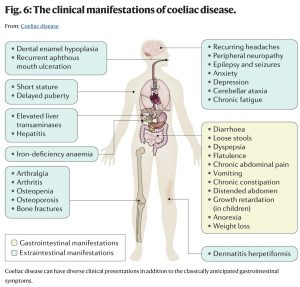The purpose of this assignment is to enhance the student’s understanding of the important role that definitions have in the context of technical writing. The assignment task is to produce three types of definitions (parenthetical, sentence, and expanded) of the chosen term. The appropriate type of definition to be used is dependent on the audience and the particular situation at hand. The audience’s current level of knowledge and their use for the definition will determine the level of detail provided in the definition. In this case, the term celiac disease will be defined by a Registered Dietitian to their client.
Parenthetical Definition:
The Registered Dietitian informed the client that the gastrointestinal symptoms they are experiencing are a result of celiac disease (permanent gluten intolerance).
Sentence Definition:
Celiac disease is a genetically based food intolerance to gluten that is characterized by gastrointestinal and extraintestinal symptoms, including abdominal pain, chronic constipation and/or diarrhea, severe bloating, anorexia, vomiting, fatigue, and iron deficiency anemia (Guandalini et al., 2014).
Expanded Definition:
Analysis of Parts
Celiac disease is a permanent gluten intolerance that has a genetic basis. To grasp a better understanding of this definition, consider the individual components of the disease:
- Gluten intolerance: Gluten is the protein found in wheat, rye, and barley. Gliadin is the glycoprotein (carbohydrate-bound protein) of gluten that reacts with the immune system. The unique structure of gliadin prevents it from being entirely digested by intestinal enzymes, so the undigested portion is left behind in the digestive system. This undigested portion of gliadin reacts negatively with a variety of cells in the body, in turn creating an intolerance with an array of symptoms (Rampertab & Mullin, 2016).
- Genetic: Celiac disease has a genetic predisposition, in that individuals suffering from the disease share a particular gene sequence. The sequence itself is complex and not fully defined, though it includes two DNA variations of the human leukocyte antigen (HLA; a complex of genes important for the immune system), known as HLA-DQ2 and HLA-DQ8, as well as 40 non-HLA genes (Rampertab & Mullin, 2016).
Etymology
“Coeliac” is derived from the Greek word “koiliakos”, which means abdominal – referring to the plethora of abdominal symptoms that the disease causes (Freeman, 2015).
History
The emergence of wheat cultivation methods 10,000 years ago saw a transition from hunter-gatherer to agricultural lifestyles. Data from fingerprinting studies that assessed historical plant species in southeastern Turkey revealed that grains evolved to have had increasing levels of gliadin content, the immunogenic component of gluten. This was an important finding for the increasing prevalence of celiac disease. Greek physicians in the 1850s who studied patients suffering from the clinical features of celiac disease used the word “coeliac” to detail their case records. The late 1800s saw a British physician discover that dietary changes – notably, the introduction of more mussels, ‘the banana diet’, and eventually gluten-free diets, led to symptom reduction. Technological advancements in the 1950s made it possible for pathological evaluation of the small intestine, with treatment options becoming futher advanced to today (Freeman, 2015).
Visual

Figure 1: The clinical manifestations of celiac disease. Source: https://www.nature.com/articles/s41572-018-0054-z/figures/6
Celiac disease is a genetically based food intolerance to gluten that is characterized by gastrointestinal and extraintestinal symptoms, including abdominal pain, chronic constipation and/or diarrhea, severe bloating, anorexia, vomiting, fatigue, and iron deficiency anemia (Guandalini et al., 2014). The visual above details the clinical signs and symptoms of celiac disease, and the specific effects this disease has on each area of the body.
This document uses various forms of definitions to define celiac disease to a patient from the lens of a Registered Dietitian, allowing the student to develop a deeper understanding of the importance of definitions in technical writing.
References Cited
Freeman, H. (2015). Celiac Disease: A Disorder Emerging from Antiquity, Its Evolving Classification and Risk, and Potential New Treatment Paradigms. Gut And Liver, 9(1), 28-37. doi: 10.5009/gnl14288
Guandalini, S., & Assiri, A. (2014). Celiac Disease. JAMA Pediatrics, 168(3), 272. doi: 10.1001/jamapediatrics.2013.3858
Lindfors, K., Ciacci, C., Kurppa, K., Lundin, K., Makharia, G., & Mearin, M. et al. (2019). Coeliac disease. Nature Reviews Disease Primers, 5(1). doi: 10.1038/s41572-018-0054-z
Rampertab, S., & Mullin, G. (2016). Celiac Disease. Farmington, Connecticut: Humana Press.
Leave a Reply